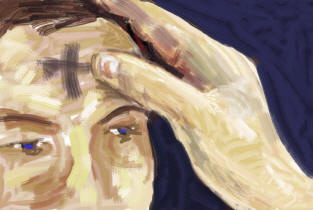
Just something to think about next time you watch those dancing queens go twirling by in their elaborate feathered costumes.And here’s something else, for those who are dragging themselves out of the sack kind of hung-over this morning:La Paz Street, in the northern zone of Oruro, is a hectic place. At three o’clock last Friday afternoon, young people, devotees, dancers and folklorists in general hurried to pick up their costumes and colorful masks, some of them made with natural feathers and the skins of armadillos, a species in danger of extinction.If you look a little closer, in the market stalls you’ll also see rattles, bird crests and bills, plumes, shells and other items made from severed parts of animals en route to extinction.It’s the dark side of Carnaval, the festive Oruro Carnival.The artisans and embroiderers are aware that the trade in animal parts is prohibited, but in fact there is no law to stop or prevent the killing of wild animals and endangered species.On one side of La Paz Street, a few metres away from the Flores Tailor Shop, lie the scattered remains of armadillos whose hides are sought after by the makers of dancers’ costumes. Each skin costs between 100 and 150 bolivianos on the black market.The “quirquinchos”, as they are commonly known, are in danger of disappearing from the sandy area of Oruro.The next day, during the Entrada de Peregrinación, and on Carnival Sunday, the Morenada Central and Morenada Comunidad “Cocani”, the largest folkloric societies, carry ostentatious rattles made from armadillo hides. The masked dancers wear ostrich feathers which adorned the heads of beautiful women whose hats are also trimmed with peacock plumes.Where do these animal parts come from? “From La Paz Street,” is what you’ll hear from a dealer.Flamingo feathers are sold as some kind of legal product in central bazaars, two blocks away from the Plaza 10 de Febrero, on Adolfo Mier Street in the heart of Oruro. Each one costs between 50 and 70 bolivianos (around $5 US.) Embroiderers make crests, to be worn on the head, for $300 apiece.It’s a great deal.The mask-makers, also known as “hojalateros”, use stuffed condors–a species near extinction, and a national emblem–in the costumes they build for the “diablada” fraternities, such as Ferroviaria, Auténtica, Artística, Urus, and others. Each mask of this type costs at least $300. But there are also manufacturers whose specialty is condor suits. Each one, made from the feathers of the actual bird, costs ome 250 bolivianos, a little under $30.Carnival Saturday and Sunday is also observed by the Suris fraternities, who perform a dance from the Andean altiplano as thanks to Pachamama, the Earth Mother. They use the feathers of the suris, birds of the same family as the flamingo and the parihuana. Each suri feather on the dancers’ hats is valued at between 20 and 30 bolivianos, around $5 US.These are some of the extremes incurred by the Oruro Carnival, declared by UNESCO as a masterpiece of the oral and intangible heritage of humanity.According to Anakarlem Mercado, folklorist and member of the Society for the Protection of Animals and Environments, “a specific law is needed” to regulate the mechanisms for the protection of the lives of animals, whose bones are sold as expensive merchandise in Bolivian folkloric activities.“The authorities must take into account that Bolivia is one of the countries most rich in biodiversity and for that, we need to have a specific law for the protection of animals, and so prevent the depletion of endangered species in folkloric events such as the Oruro Carnival,” Mercado tells ABI.Mercado reminds us that in Bolivia the Law of the Environment, promulgated on April 27, 1992, is still in force. It regulates hunting and prohibits the indiscriminate trafficking in endangered animal species. It reads, “Whoever introduces, captures, promotes and/or commercializes the products of hunting, possession, stockpiling, transportation of animal or vegetable species or their derivatives without authorization, or those which are declared out of season or reserved, placing the same at risk of extinction, shall suffer the penalty of up to two years’ deprivation of liberty.”
Translation mine as well.The induced-abortion death of the teenager is not really carnival-related (it happens all year round, particularly in predominantly Catholic countries where abortion is illegal, birth control hard to come by, and medical resources poor. Countries like Bolivia, for example.) But the drunkenness, violence and the road fatalities are all preventable. As is unwanted pregnancy, come to that.Prevention beats thAt least 24 people are dead and dozens injured as a result of the festivities of the Bolivian Carnival, according to the provisional report distributed by the police on Tuesday. The majority of the deaths occurred as a result of traffic accidents. Also to blame was the excessive consumption of alcohol and street violence, according to the report.The police report indicates that the deaths occurred in the departments of La Paz, El Alto, Santa Cruz, Oruro, Cochabamba and Chuquisaca.Colonel Miguel Narváez, commander of operations, said that in La Paz alone there were five deaths and 74 injured persons reported.The most notorious case was the death of a retired police general, Antonio Pardo Montalvo, last Saturday in a traffic accident on the road between the cities of Oruro and Cochabamba.Police reports also indicate that last Saturday, a cyclist was struck on the road to Copacabana, and on Sunday a married couple were killed on the road to Oruro. On Monday, an indigent was murdered in a party at a butcher shop. “This year there were more accidents than last year. The number of deaths in the city of La Paz was smaller. Of 82 accidents reported, 15 were caused by drunkenness,” Col. Narváez reported.In the Hospital Clinic of La Paz there were 17 persons brought in during the early hours on Tuesday morning, the majority of them with stab wounds or cuts received in brawls, according to Dr. Jaime Mancilla. “There were 15 patients with cuts in various places, and two suffering from alcohol poisoning,” Dr. Mancilla said.In Chuquisaca, the police reported five deaths between Saturday and Tuesday. “We must lament the fact that amid the festivities of Carnaval, there were five deaths, among them a girl of 16 who died as a result of an induced abortion,” said the commander of police in Chuquisaca, Juan Córdova. To guarantee the security of the citizens during Carnaval, the police deployed 15,237 officers nationwide.
e shit out of penitence, as far as I’m concerned.



